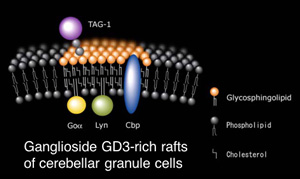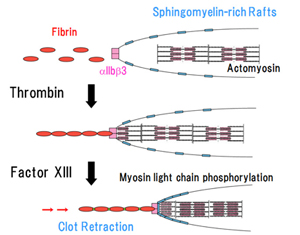
- HOME
- Laboratory of Biomembrane
Laboratory of Biomembrane
Kohji Kasahara has been the head of the Laboratory of Biomembranes at TMIMS since 2020. He obtained a BSc in Chemistry from the Tokyo Institute of Technology in 1986, a MSc in 1988, and a PhD from the University of Tokyo in 1992. After graduating, he worked at TMiMS as a research scientist from 1992 to 2003, as an independent scientist from 2003 to 2005, as a project subleader from 2005 to 2010, and as a team leader from 2010 to 2020. He also worked at PRESTO, Japan Science and Technology Agency from 2001 to 2005.
Research Summary
We are studying the function of lipid rafts. Lipid rafts are dynamic assemblies of glycosphingolipids, sphingomyelin, cholesterol, and proteins that can be stabilized in microdomains on cell surfaces. They are involved in the regulation of a number of cellular processes including axonal guidance, cellular migration, and blood clot formation and retraction.
In order to understand how lipid rafts receive external signals and transduce them to internal changes, we have been identifying protein interactions of glycosphingolipids in cerebellar granule cells from the nervous system, and in platelet cells from the blood.
In cerebellar granule cells we found that anti-ganglioside GD3 antibodies co-precipitate the GPI-anchored neural cell adhesion molecule TAG-1, the src-family kinase Lyn, its substrate Cbp, and the trimeric G protein Goα. TAG-1 is important for axonal guidance, and cellular migration. However, GPI anchors have no direct contact with the cytoplasm so it was unclear how TAG-1 activation causes internal cellular changes required for axonal guidance or migration. We demonstrated that TAG-1 transduces signals through interactions with Lyn/Cbp proteins found in ganglioside GD3-rich rafts of cerebellar granule cells. We further found that the chemokine SDF-1α triggers the chemoattraction of cerebellar granule cells during cerebellar development. SDF-1α stimulates GTPγS binding to Goα, and causes Goα translocation to lipid rafts, leading to growth cone collapse of cerebellar granule cells.
In blood platelets, sphingomyelin-rich lipid rafts are important for both blood clot formation and retraction through interaction with fibrin. We have identified a factor XIII-dependent fibrin-integrin αIIbβ3-myosin axis in sphingomyelin-rich membrane rafts that is important in clot retraction.


Members
Laboratory Head Kohji Kasahara
- Tetsuya Hirabayashi
Selected Publications
- Komatsuya et al. (2022) “Phosphacan acts as a repulsive cue in murine and rat cerebellar granule cells in a TAG-1/GD3 raft-dependent manner” J Neurochem 163(5) 375-390
- Komatsuya K et al.(2020) “Function of Platelet Glycosphingolipid Microdomains/Lipid Rafts.” Int. J. Mol. Sci. 21(15) :5539.
- Kasahara K, et al. (2013) “Clot retraction is mediated by factor XIII-dependent fibrin-αIIbβ3-myosin axis in platelet sphingomyelin-rich membrane rafts.” Blood 122, 3340-3348.
- Kasahara K, et al. (2010) “Impaired clot retraction in factor XIII A subunit-deficient mice.” Blood 115, 1277-1279.
- Yuyama K, et al. (2007) “Translocation of activated heterotrimeric G protein Gαo to ganglioside-enriched detergent-resistant membrane rafts in developing cerebellum.” J.Biol.Chem. 282, 26392-26400.
- Kasahara K, et al. (2000) “Involvement of gangliosides in GPI-anchored neuronal cell adhesion molecule TAG-1 signaling in lipid rafts.” J.Biol.Chem. 275, 34701-34709.
- Kasahara K, et al. (1997) “Association of src family tyrosine kinase Lyn with ganglioside GD3 in rat brain. Possible regulation of Lyn by glycosphingolipid in caveolae-like domains.” J.Biol.Chem. 272, 29947-29953.

